Tecate Mexico
During my 1999 trip to California it had occurred to me that next time I could possibly go through into Mexico for a while. It would have to be on foot, because rental cars cannot be taken into Mexico. The place most people go through is Tihuana, which is a coastal tourist resort, but I heard that there were massive queues to get back into the USA, and also it is probably not very typical of Mexico. It seemed better to try somewhere more inland, and Tecate, about 40 miles from the coast came to mind.
In 2005 I was driving to Los Angeles from Monument Valley and the Grand Canyon via Lake Havasu, Yuma and San Diego, which would take me along the Mexican border. By then we had had 9/11, and entry to the USA had become more difficult, so I thought there might be complications in going through into Mexico, or at any rate, in coming back.
From my night stop in Yuma I took Interstate 8, the freeway running westwards parallel to the border, and after a few miles was surprised to see an area of Sahara type sand dunes, which are unusual in the American desert. These are the Algodones Dunes, the largest area of dunes of that type in the USA.. After about 15 miles I branched off on to highway 98, a single carriageway road much closer to the border, running through agricultural land around Mexicali and then the Yuha Desert until it rejoins the freeway. Shortly afterwards the road climbs steeply into the mountains for several miles, with telephones and supplies of radiator water every half mile, so presumably this route has a reputation for causing vehicles to break down.
 After some distance I branched off to the left again onto highway 94, which runs to within about 50 yards of the border in places. There is an ongoing problem with Mexicans trying to obtain illegal entry into the USA by crossing the desert or mountains, and a considerable number die of thirst or exposure in the process. The border just consists of a fence, and the road is heavily patrolled by Border Control officers in white 4x4s. On the Mexican side of the fence are blue flags every so often, marking the position of water containers.
After some distance I branched off to the left again onto highway 94, which runs to within about 50 yards of the border in places. There is an ongoing problem with Mexicans trying to obtain illegal entry into the USA by crossing the desert or mountains, and a considerable number die of thirst or exposure in the process. The border just consists of a fence, and the road is heavily patrolled by Border Control officers in white 4x4s. On the Mexican side of the fence are blue flags every so often, marking the position of water containers.
The mountains in this area are very barren and hostile, some appearing to be just enormous heaps of large boulders which would be almost impossible to cross. In a place called Compo I stopped at a café for a snack. It was run by two blokes named Bill and Don or something like that, and I asked them if it was possible to go through into Tecate, which was a few miles down the road. They said there should be no problem, so I took the turn off to Tecate, and the road climbed steeply with bare rocks on either side until it opened out into an area with some 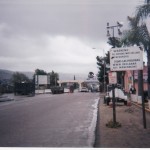 warehouse-type buildings around. Ahead was a gantry over the road with a fancy sign and the word MEXICO in big brightly coloured letters. It looked more like the entrance to a fairground than a country. By now it had been raining hard for some time, and there was mud and water all around.
warehouse-type buildings around. Ahead was a gantry over the road with a fancy sign and the word MEXICO in big brightly coloured letters. It looked more like the entrance to a fairground than a country. By now it had been raining hard for some time, and there was mud and water all around.
There were three car parks, all of which looked like breakers' yards, one of them being two inches deep in mud all over. I parked the car at the side of the road where there was 20min. waiting and went to scout around. In front of the gateway to Mexico was a Border Control Officer sitting in a jeep, watching to make sure that no Mexicans came out through the 'in' gate. The 'out' gate was in a different place about 200 yards away. I asked the officer if he thought I would have any problem in going into Mexico and he said I wouldn't have as long as I had a passport.
After another look at the car parks I chose what appeared to be the best one and was relieved to find a very pleasant young lady in the Portacabin, so it seemed likely that the wheels might still be on the car when I got back.
The pedestrian entrance into Mexico was through a large turnstile, on the other side of which was a man in uniform with a machine gun. The turnstile clanged behind me and he directed me into an office. I decided to follow his orders, and went into the office, which was like something out of a film. There were two corpulent men with black moustaches sitting at desks. I held out my passport and said I would like to go into Tecate. One of them said "Why? What you want?" "I just want to see what it is like". "Why? Where you go? What you do?" "I just want to look round Tecate" "Just Tecate?" "Yes". "All right". That was it. I was in Mexico.
Tecate is an extraordinary place. If you look at Google maps you will see that the northern boundary of the town runs along the top of the mountains in a dead straight line which is the US/Mexico border, with almost nothing on the Californian side. Within a few yards you go from a bleak mountain top in California into the back streets of a Mexican town of 50,000 people, and it was very Mexican, somehow more so than I had expected.
Not surprisingly, it was a downhill walk from the border to the town centre. The street led to the main square, which had a small circular pavilion surrounded with trees. There were few people about because it was still raining fairly hard. On the way I had crossed a number of busy streets with battered cars and beaten-up buses like old American school buses, belching out black smoke, a contrast from California a few 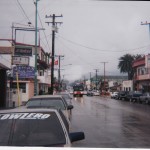 miles away. The buildings in the square were quite tidy, but elsewhere there was quite a bit of graffiti and virtually nothing of architectural note. The smartest building was the ubiquitous McDonalds, which I managed to resist and went into another café for a cup of coffee. Fortunately they were happy to accept payment in dollars, because I had no Mexican money.
miles away. The buildings in the square were quite tidy, but elsewhere there was quite a bit of graffiti and virtually nothing of architectural note. The smartest building was the ubiquitous McDonalds, which I managed to resist and went into another café for a cup of coffee. Fortunately they were happy to accept payment in dollars, because I had no Mexican money.
It was mid-afternoon on a weekday, but there were bars everywhere occupied by men with black moustaches, which are de rigueur in that part of the world. With blue eyes and no moustache I felt like a very obvious gringo, the only one in town as far as I could see, and even if I had had time to grow a moustache it wouldn't be black. At one point four policemen went past in a VW Golf, and one of them glared at 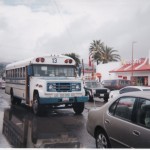 me in a manner to suggest that he would very much like to clap me behind bars if he could think of a reason.
me in a manner to suggest that he would very much like to clap me behind bars if he could think of a reason.
There were shops and business premises providing various services, but they were not the sort of places you could wander into and look around, especially with no knowledge of Spanish. In a lane off one of the main streets I found some stalls where people were sheltering under cover trying to sell cheap clothing and bric-a-brac to passers by, of which I seemed to be the only one, and I passed by.
Tecate is probably best known elsewhere as a brand of beer, and the brewery is undoubtedly the largest business in the town. The fact that there were so many men in the bars was an indication that there is a high level of unemployment, which is why Mexicans are so desperate to get into the States. The area is also noted for corruption and large-scale drug dealing, and not long after my visit four policemen were found a few miles away with their heads cut off (I didn't do it).
After a couple of hours in the rain I made my way to the US immigration office, which was in a street parallel to the one where I had come in. Totally contrary to everything I had heard, there was no queue and the two officers were sitting there with nothing to do. They examined my passport and waved me through. As I walked into the USA I had that same feeling of guilt that I got in the 1960s when returning to the West from East Berlin or Hungary - it had been so easy for me to do something that the people I was leaving behind were risking their lives to do.
Locked out in the Desert
Locked out in the desert - saved by the Germans.
It was April 1999, my second trip to California to visit my cousin in Los Angeles, and second trip to Death Valley. I 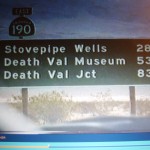 had flown to Reno in Nevada, and driven down highway 395 on the eastern side of the Sierra Nevada mountains. At Lone Pine I stopped and bought some bottled water, which you are always advised to do before going into the desert, and turned off onto highway 190 towards Death Valley. For some distance the road runs through mountains, but then drops down and levels out, into long straights stretching far into the distance, with the mountains set back several miles on either side. There was very little traffic on the road.
had flown to Reno in Nevada, and driven down highway 395 on the eastern side of the Sierra Nevada mountains. At Lone Pine I stopped and bought some bottled water, which you are always advised to do before going into the desert, and turned off onto highway 190 towards Death Valley. For some distance the road runs through mountains, but then drops down and levels out, into long straights stretching far into the distance, with the mountains set back several miles on either side. There was very little traffic on the road.
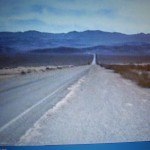 A few miles after passing Panamint Springs, which just consists of a small gas station, motel and restaurant, I wanted to make a video showing the desolation of that part of the desert, and waited until I came to a suitable spot. The road was dead straight and flat as far as the eye could see in both directions. I got out of the car with the camcorder, and panned around, satisfied that I had captured the stark isolation of the desert, and went to get back into the car. Shock, horror, the door was locked and I could see the key still in the ignition.
A few miles after passing Panamint Springs, which just consists of a small gas station, motel and restaurant, I wanted to make a video showing the desolation of that part of the desert, and waited until I came to a suitable spot. The road was dead straight and flat as far as the eye could see in both directions. I got out of the car with the camcorder, and panned around, satisfied that I had captured the stark isolation of the desert, and went to get back into the car. Shock, horror, the door was locked and I could see the key still in the ignition.
The sun was blazing out of a clear sky, and the temperature was about 85ºF (in the heart of Death Valley it was 110º). I was just wearing a T-shirt and shorts, with no hat or other protection of any sort. I picked up a rock and tried to break one of the little side windows behind the rear doors, but it absolutely refused to break. Possibly I could have broken the windscreen, but I did not want to do that at that stage, 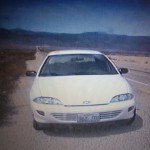 because it was a rental car and a replacement would be expensive, apart from which I would have to drive a long way without it.
because it was a rental car and a replacement would be expensive, apart from which I would have to drive a long way without it.
After a while a car came along and stopped. It was travelling towards Death Valley, and as I was within the National Park I asked the driver to tell the rangers where I was. On my previous visit I had encountered rangers patrolling the roads from time to time, but so far this time I hadn't seen any.
After about ½ hour a people carrier came along and stopped. It turned out to be occupied by two middle-aged German couples. I explained the situation to them and they said they would go back to Panamint Springs and try to get assistance. After about 20 minutes they came back and said they had phoned through to a breakdown service in Lone Pine, and the people would be with me in about an hour. Lone Pine was 55 miles away. The Germans gave me a bottle of water and some white paper towel to put on my head, and departed. I thanked them profusely and they disappeared towards Death Valley.
As I waited it seemed to get hotter and hotter. A couple of other cars and a motorcycle stopped and I explained that help was on the way, so they went off. After I had been there about two hours I was beginning to get desperate and on 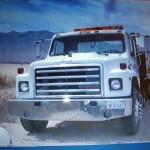 the point of breaking the windscreen when the breakdown truck arrived. It was manned by two all-American boys with baseball caps who produced a long thin strip of metal that you could buy in Wal-Mart for a few dollars, slipped it down though the door seal and in seconds the door was open.
the point of breaking the windscreen when the breakdown truck arrived. It was manned by two all-American boys with baseball caps who produced a long thin strip of metal that you could buy in Wal-Mart for a few dollars, slipped it down though the door seal and in seconds the door was open.
I asked how much I owed them, and the one in charge said he guessed it would be 100 bucks. If they hadn't been coming out to someone else as well it would have been 200. Considering the distance they had driven and the time I felt that that was actually not at all bad.
A couple of days later, as soon as I got back to civilisation I went into Wal-Mart and got a duplicate key made for the car. Unfortunately, with the modern high tech keys it is no longer possible to do that, and nowadays you just have to guard the single key with your life.
Apologies for poor photos, which were extracted from video.
London Bridge, Arizona
When my Mini broke down on London Bridge in 1962 I could not have imagined that I would be driving over the same bridge again in a small desert town in Arizona 43 years later.
When it was decided that London Bridge would be replaced by a new one in 1967 an American oil baron named Robert McCulloch expressed an interest in buying it. The story goes that he thought he would be getting the more spectacular Tower Bridge, but that has been denied by all the people actually involved.
 Mr.McCulloch had founded a city in the Arizona desert called Lake Havasu, and he thought the bridge would be a tourist attraction. In effect the site of the bridge is across the end of a lake, connected to a canal. The old bridge was not shipped lock, stock and barrel to Arizona. The Lake Havasu bridge is actually a new reinforced concrete structure, entirely clad in stone from the old one. It looks just like the old one, excepting that it is much cleaner than I remember it being in London, and probably looks more as it did when it was originally opened in 1831.
Mr.McCulloch had founded a city in the Arizona desert called Lake Havasu, and he thought the bridge would be a tourist attraction. In effect the site of the bridge is across the end of a lake, connected to a canal. The old bridge was not shipped lock, stock and barrel to Arizona. The Lake Havasu bridge is actually a new reinforced concrete structure, entirely clad in stone from the old one. It looks just like the old one, excepting that it is much cleaner than I remember it being in London, and probably looks more as it did when it was originally opened in 1831.
In the area around the bridge there are the usual British icons, a double decker bus, telephone kiosk, pillar box etc. The view through the arches of the bridge is actually very attractive, to my mind rather better than it was in London. From what I had read I was under the impression that the bridge just stood on its own in the desert, but in fact it is an important part of the road network in Lake Havasu and used by people in the course of their everyday lives. I drove over the bridge in both directions, but I could not identify the place where I broke down in 1962 because it was not possible to tell which way round the bridge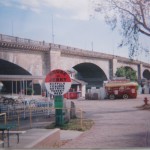 was in London.
was in London.
Everything stolen – Miami 1995
It was the Saturday before the end of my Florida holiday, and I was flying home from Orlando on the Tuesday. I had booked in for two nights at the Jolly Shores Motel in North Fort Lauderdale, and decided to spend the day in Miami, taking in some places that I had not been to before.
On the Saturday morning I put a small sports bag containing things that I did not want to leave at the hotel or carry on my person into the boot of the car, and set off for Miami, a distance of about 28 miles. The car was a Nissen Sentra, with a proper boot, rather than a hatchback.
During the day I left the car parked in five or six places in Miami, mainly car parks, but a couple of times in the street. In the evening a I got back to the Jolly Shores at 9.00pm, by which time it was pitch dark, and drove to the car park at the back. I opened the boot to take out the bag, and there it was - gone! At first I could not believe it, but then looked at the panel around the boot lock, and could see that it was slightly distorted, where someone had put a screwdriver in the lock and forced it sideways. It was a very poor design, and would have taken very little time or effort to release the catch.
The bag had contained my passport, driving licence, air tickets, car hire documents, insurance documents, house keys, camera, camcorder, binoculars, shaver, and a few other bits and pieces. Fortunately I had taken my credit cards and some money with me, and there was some more money hidden inside the car. I was a bit worried about the house keys, because the person who had them also had my address, but it was unlikely that they would be able to get the keys to anyone in England before I got home. Loose in the boot had been some motorcycle parts that I had bought from Orlando Yamaha, and they were also missing.
I went into the motel and asked the manager if I could ring the police. He was reluctant at first, because motels never like being visited by the police for any reason, but he eventually agreed and I spoke to an officer, who said someone would come to the motel. Shortly afterwards a policeman arrived and I told him what had happened. He asked where the theft had taken place and I said I did not know exactly, but it was in Miami. He immediately said "If it happened in Miami you must report it in Miami". There was no way that he was going to allow a Miami crime to get into the Fort Lauderdale statistics. I rang the Miami police, and they said I should go down to the main police station in the morning.
The first thing I did on the Sunday morning was to ring the British Consulate in Orlando to arrange for a replacement passport, but I just got a recorded message saying that they were closed until Monday, but if I wanted to report a death I should ring a number in Atlanta.
Actually, I did not mind going to the police headquarters in Miami, because it was still around the time of the Miami Vice series, and I thought it might be quite interesting. When I got there I was told to wait in the entrance hall, and someone would come to see me. I had imagined that there would be a constant string of drug dealers being led through in handcuffs, and possibly a shoot-out, but all that happened was that an old lady came in and asked if she could use the toilet.
Another figment of my imagination was that I would be interviewed by a big, hard looking officer called Lewtenant Chuck Brubaker, but a young man appeared and introduced himself as Gary Green. He took me to his office, noted the details, and gave me the paperwork I needed for an insurance claim. He also came outside and looked at the car.
My flight was on the Tuesday afternoon, so I had to get back to Orlando for the Monday morning so that I could start to sort things out. It was about 250 miles to Orlando, which was not too difficult, and I booked in at a motel not far from the city centre and airport. On the Monday morning I rang the consular office and told them what had happened. The lady was very nice and said she would ring back shortly. I said I would be by the phone, as I was not going anywhere, and she said "No, you won't be, without your passport, will you". She rang back and told me I should get some passport photographs and go to the office on Tuesday morning. I had mentioned that the one thing I was not short of was money, and she sounded very relieved, because most of the people who go to that office are youngsters who have run out of money, hoping to get a sub from HM Government.
I rang Orlando Yamaha, and they said they could get replacements for the stolen parts for the Tuesday morning. The next stage was to go to the airport and get replacement air tickets, which cost about £60. Then on to Kmart for passport photos.
On the Tuesday morning I went to the consular office, which is about two thirds of the way up a sky-scraper in the city centre. It is actually the most visited British outpost in the world, but when I arrived there were no customers. The people could not have been more pleasant and helpful. They took the photos and produced a temporary passport in a very short time. It was like an A4 sheet of paper, but I had no problem with it on the journey home. On to Orlando Yamaha, who had the parts ready.
When I took the car back there was a little bit of a fuss, and they photographed the boot lock, but there were no repercussions.
As soon as I got home I made an insurance claim, and they paid for everything excepting the replacement air tickets, which were not covered.
This incident taught me a lesson about looking after my valuables when travelling abroad, and I am now very much more careful. The Foreign Office recommends that you leave things in the hotel safe, but that is not a viable proposition if you are moving on every day, and in some of the hotels I stay in it is doubtful whether anywhere is safe. Nowadays I keep my passport and other important documents with me, and if there is anything in the car boot I avoid opening it after parking in places that are at all risky.